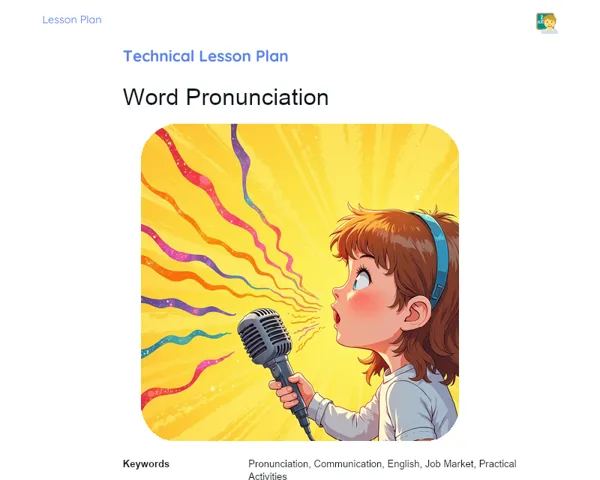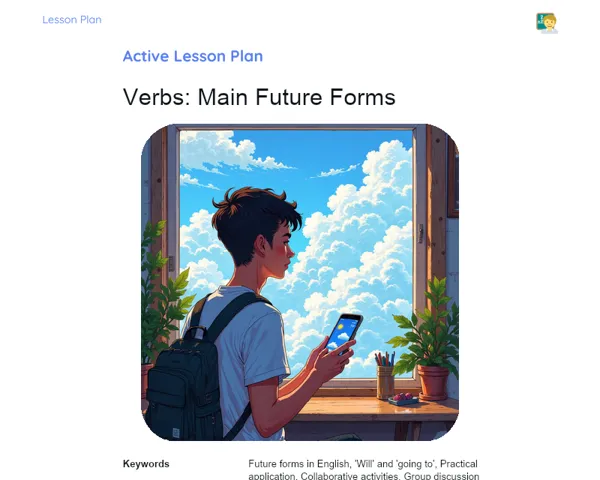Lesson Plan | Lesson Plan Tradisional | Verbs: Introduction to the Verb to Be
| Keywords | Verb to be, English, Grade 3, Lecture, Affirmative and negative forms, Am, is, are, Simple sentences, Problem solving, Student engagement, Practical examples |
| Resources | Whiteboard or chalkboard, Markers or chalk, Printed practical exercises, Projector (if needed), Presentation slides (if required), Papers, Pencils or pens |
Objectives
Duration: (10 - 15 minutes)
The purpose of this lesson plan step is to provide a concise overview of the primary objectives that students should accomplish by the end of the lesson. This clarity helps both the teacher and students understand the key takeaways, laying a firm groundwork for the upcoming lecture.
Objectives Utama:
1. Comprehend the function and significance of the verb to be in the English language.
2. Learn to conjugate the verb to be in both affirmative and negative forms.
3. Identify and use am, is, and are correctly in straightforward sentences.
Introduction
Duration: (10 - 15 minutes)
📝 Purpose: The aim of this lesson step is to set the scene and ignite students' interest in the topic. By discussing the importance of the verb to be and sharing intriguing facts about its usage, students will feel more invested and motivated to learn. This paves the way for the detailed explanations that follow, enhancing their understanding and retention of the material.
Did you know?
🧐 Curiosity: Did you know that the verb to be pops up in some of the most iconic lines in history? For example, the famous phrase 'To be or not to be, that is the question' from Shakespeare's Hamlet features to be. Additionally, this verb is often among the first that children learn when they begin speaking English, just as we are doing in our class right now!
Contextualization
📖 Context: Before diving into the lesson on the verb to be, it's essential to highlight its relevance within the English language. Explain that to be is one of the most pivotal and commonly used verbs in English, crucial for forming basic sentences that express states, identities, and traits. A solid understanding of to be is essential for effective communication, as it enables students to convey simple yet important information in English. Hence, mastering to be is a fundamental skill for anyone learning the language.
Concepts
Duration: (40 - 45 minutes)
📚 Purpose: This section of the lesson plan aims to deliver a detailed and coherent explanation of the verb to be, its forms, and its uses. By systematically covering the topics, the teacher ensures that students grasp each element before moving forward. Additionally, practical examples and guided exercises bolster learning, allowing students to practise using to be in various scenarios. Ultimately, this ensures students can use the verb appropriately in their sentences by the lesson's conclusion.
Relevant Topics
1. 🌟 Specific Topics:
2. What is the verb to be? Clarify that to be means 'to be' in English (it translates to 'ser' or 'estar' in Afrikaans). It's used to articulate states of being, identities, and characteristics. For instance, 'I am a learner' and 'She is content'.
3. Forms of the verb to be Highlight that to be has three forms in the present tense: am, is, and are. Explain that am is used with I, is with he, she, and it, and are with you, we, and they.
4. Usage in Affirmative and Negative Sentences Demonstrate how to be functions in affirmative and negative sentences. For example, 'She is a teacher' and 'She is not a teacher'. Teach how to contract the negative form, for instance, is not becoming isn't.
5. Practical Examples Provide various sentences employing the verb to be in its different forms. For example, 'I am a boy', 'He is my mate', 'They are in the garden'.
6. Guided Problem Solving Suggest exercises where students fill in gaps with the appropriate form of to be. For instance, 'She ___ a doctor' (is), 'We ___ happy' (are), 'I ___ a student' (am).
To Reinforce Learning
1. Complete the sentence: 'He ___ a good person.'
2. Turn the sentence into the negative form: 'They are friends.'
3. Compose an affirmative sentence using 'I am.'
Feedback
Duration: (15 - 20 minutes)
🎯 Purpose: This step aims to review and solidify learning about the verb to be. Discussing the answers ensures students have a thorough comprehension of the content. The engagement questions stimulate critical thinking on to be and encourage practical application in various contexts, fostering deeper understanding.
Diskusi Concepts
1. 🔍 Discussion: 2. Finish the sentence: 'He ___ a good person.' 3. - Answer: 'He is a good person.' It's important to note that 'is' is the correct form of to be when referring to 'he', 'she', or 'it'. 4. Convert the sentence into the negative form: 'They are friends.' 5. - Answer: 'They are not friends.' or 'They aren't friends.' Explain that to form the negative, add 'not' after to be. The contracted form 'aren't' can also be used. 6. Create an affirmative sentence using 'I am.' 7. - Answer: 'I am a learner.' Remember that 'am' is the form of to be for 'I'.
Engaging Students
1. 🧠 Student Engagement: 2. Why is the verb to be so significant in the English language? 3. - This question encourages students to consider the importance of to be across different contexts and its frequent application. 4. How can you utilize the verb to be to discuss yourself and others? 5. - Prompt students to form sentences with 'I am', 'He is', 'She is', 'We are', etc. 6. What distinguishes the affirmative from the negative forms of to be? 7. - This fosters understanding of affirmative and negative structures while practicing sentence transformations. 8. Can you recall a famous or widely recognized sentence that includes the verb to be? 9. - This question encourages students to connect learning with familiar sentences, increasing the topic's relevance.
Conclusion
Duration: (10 - 15 minutes)
The goal of this lesson closure is to summarise and consolidate the key points covered, ensuring students understand the content in detail. Emphasizing the practical implications and significance of the topic reinforces its value, motivating students to apply their newly acquired knowledge in daily conversations.
Summary
['Comprehend the function and significance of the verb to be in English.', 'Learn to conjugate the verb to be in affirmative and negative forms.', 'Recognize and accurately use am, is, and are in simple sentences.', 'Understand the structure of affirmative and negative sentences using to be.', 'Practical examples of utilizing the verb to be across different contexts.']
Connection
This lesson effectively bridged theory with practice, thoroughly explaining the use of to be and offering practical examples and guided exercises. This approach allowed students to apply theoretical concepts to real-life situations, enhancing their learning experience.
Theme Relevance
The subject matter is vital for students' everyday interactions, as the verb to be is often used to describe states, identities, and characteristics, both in conversation and writing. Grasping and correctly using to be enhances effective communication in English, allowing students to convey essential information clearly.


